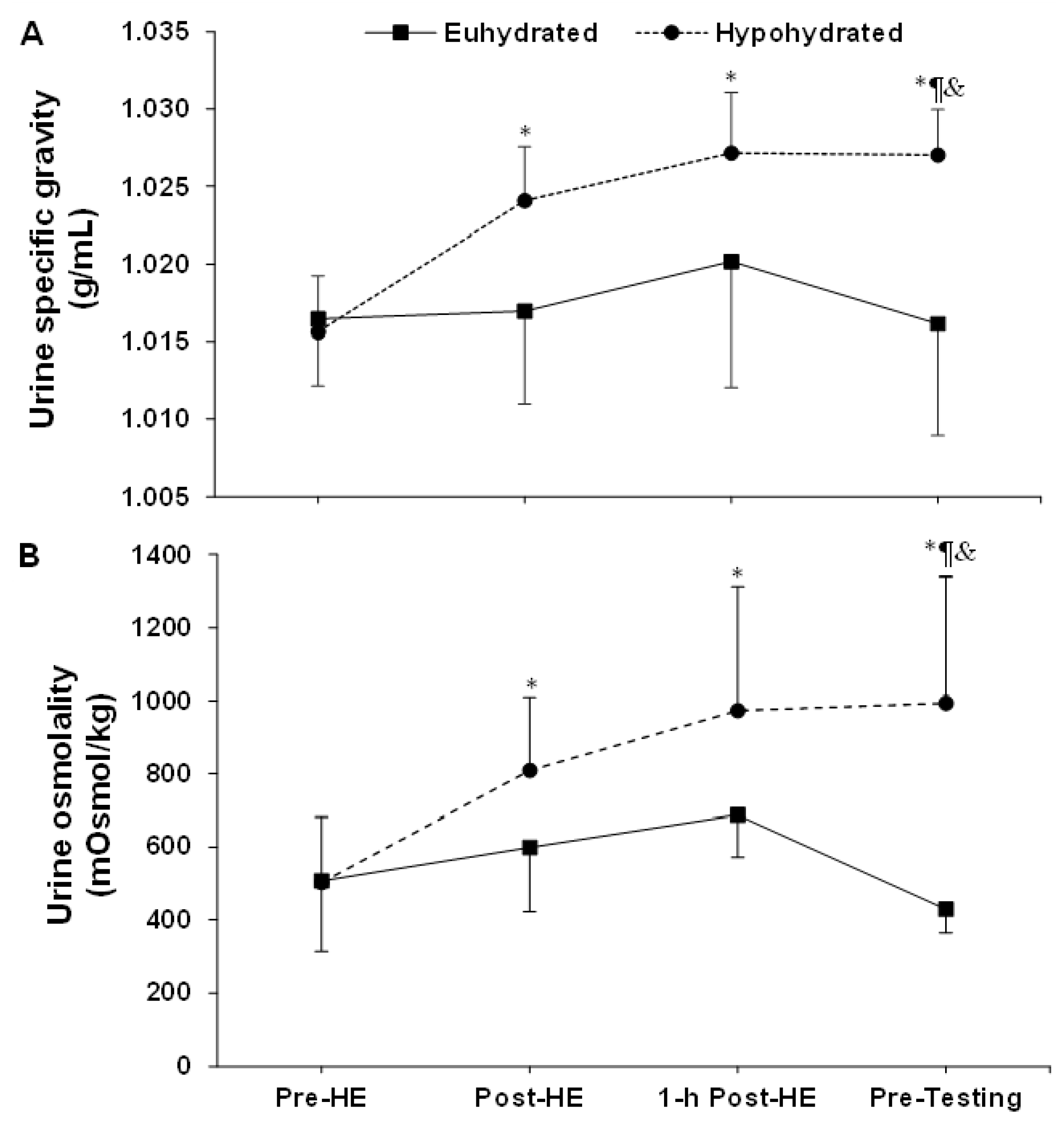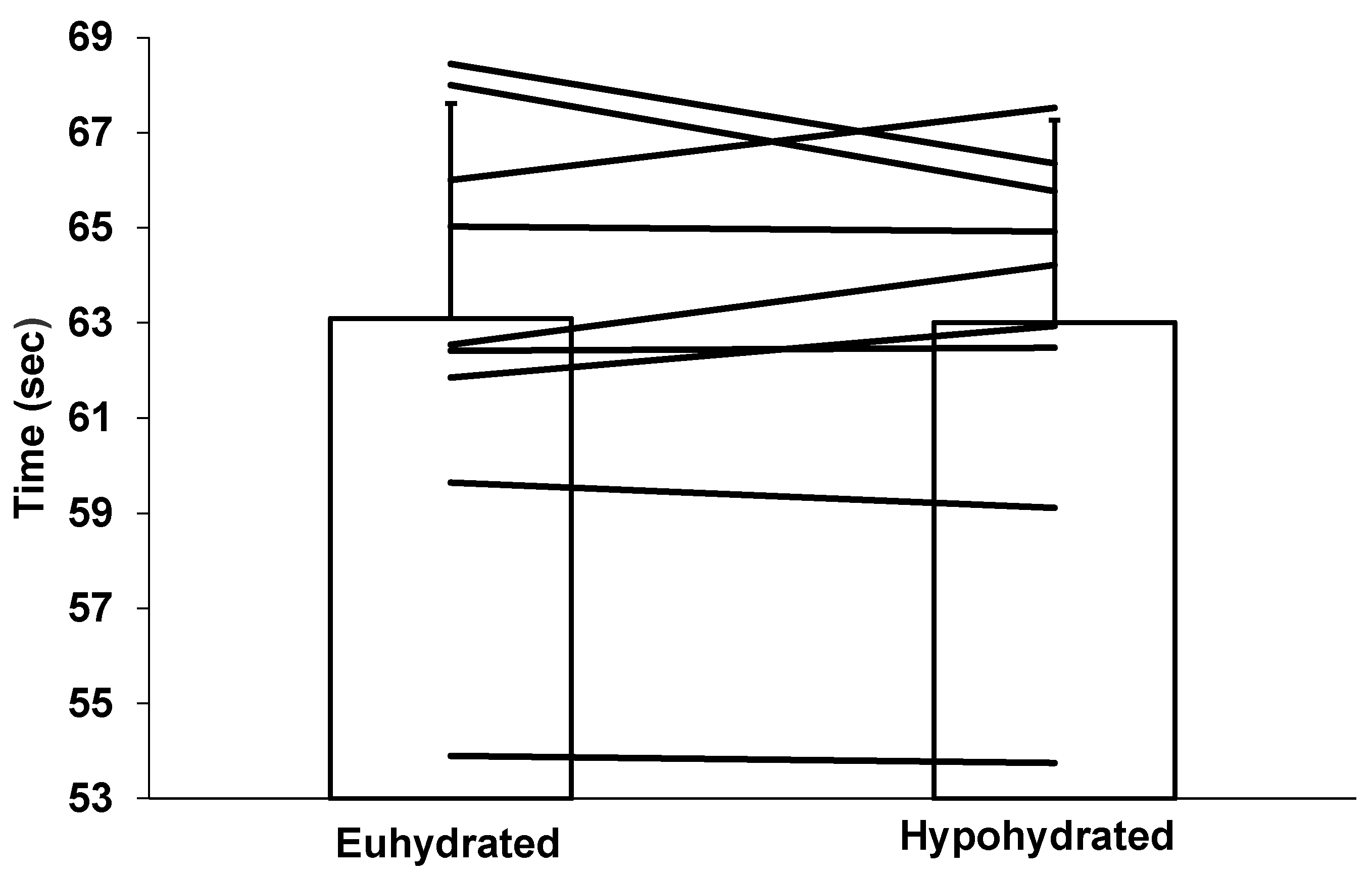Impact of Mild Hypohydration on 100 m Front Crawl Performance and Starting Block Peak Force Production in Competitive University-Level Swimmers
Abstract
1. Introduction
2. Materials and Methods
2.1. Participants
2.2. Experimental Design
2.3. Preliminary Visit
2.4. Familiarization Trials
2.5. Pre-Experimental Procedures
2.6. Experimental Procedures
2.6.1. Arrival at the Laboratory
2.6.2. Heat Exposure and Hypohydration
2.6.3. Recovery Period
2.7. Measurements
3. Statistical Analysis
4. Results
4.1. Participants’ Hydration Status at Arrival to the Laboratory
4.2. Heat Exposure Duration and Hydration Status
4.3. Rectal Temperature
4.4. Perceived Thirst and Heat Stress
4.5. 100 m Front Crawl
4.6. Peak Force Produced on the Starting Block
5. Discussion
6. Conclusions
Author Contributions
Funding
Acknowledgments
Conflicts of Interest
References
- IOC. AQUATICS: History of Swimming at the Olympic Games. 2015. Available online: https://stillmed.olympic.org/AssetsDocs/OSC%20Section/pdf/QR_sports_summer/Sports_Olympiques_natation_eng.pdf (accessed on 12 October 2020).
- FINA. 13th Fina World Championships. 2009. Available online: http://www.fina.org/competition-detailed-results/145199 (accessed on 12 October 2020).
- Born, D.P.; Stoggl, T.; Petrov, A.; Burkhardt, D.; Luthy, F.; Romann, M. Analysis of Freestyle Swimming Sprint Start Performance After Maximal Strength or Vertical Jump Training in Competitive Female and Male Junior Swimmers. J. Strength Cond. Res. 2020, 34, 323–331. [Google Scholar] [CrossRef] [PubMed]
- West, D.J.; Owen, N.J.; Cunningham, D.J.; Cook, C.J.; Kilduff, L.P. Strength and power predictors of swimming starts in international sprint swimmers. J. Strength Cond. Res. 2011, 25, 950–955. [Google Scholar] [CrossRef]
- Campos, E.Z.; Kalva-Filho, C.A.; Gobbi, R.B.; Barbieri, R.A.; Almeida, N.P.; Papoti, M. Anaerobic Contribution Determined in Swimming Distances: Relation with Performance. Front. Physiol. 2017, 8, 755. [Google Scholar] [CrossRef] [PubMed]
- Figueiredo, P.; Zamparo, P.; Sousa, A.; Vilas-Boas, J.P.; Fernandes, R.J. An energy balance of the 200 m front crawl race. Eur. J. Appl. Physiol. 2011, 111, 767–777. [Google Scholar] [CrossRef] [PubMed]
- Ribeiro, J.; Figueiredo, P.; Sousa, A.; Monteiro, J.; Pelarigo, J.; Vilas-Boas, J.P.; Toussaint, H.M.; Fernandes, R.F. VO2 kinetics and metabolic contributions during full and upper body extreme swimming intensity. Eur. J. Appl. Physiol. 2015, 115, 1117–1124. [Google Scholar] [CrossRef] [PubMed]
- Magal, M.; Cain, R.J.; Long, J.C.; Thomas, K.S. Pre-Practice Hydration Status and the Effects of Hydration Regimen on Collegiate Division III Male Athletes. J. Sports Sci. Med. 2015, 14, 23–28. [Google Scholar]
- Volpe, S.L.; Poule, K.A.; Bland, E.G. Estimation of prepractice hydration status of National Collegiate Athletic Association Division I athletes. J. Athl. Train. 2009, 44, 624–629. [Google Scholar] [CrossRef]
- Adams, J.D.; Kavouras, S.A.; Robillard, J.I.; Bardis, C.N.; Johnson, E.C.; Ganio, M.S.; McDermott, B.P.; White, M.A. Fluid Balance of Adolescent Swimmers During Training. J. Strength Cond. Res. 2016, 30, 621–625. [Google Scholar] [CrossRef]
- Arnaoutis, G.; Kavouras, S.A.; Angelopoulou, A.; Skoulariki, C.; Bismpikou, S.; Mourtakos, S.; Sidossis, L.S. Fluid Balance During Training in Elite Young Athletes of Different Sports. J. Strength Cond. Res. 2015, 29, 3447–3452. [Google Scholar] [CrossRef]
- Maughan, R.J.; Dargavel, L.A.; Hares, R.; Shirreffs, S.M. Water and salt balance of well-trained swimmers in training. Int. J. Sport Nutr. Exerc. Metab. 2009, 19, 598–606. [Google Scholar] [CrossRef]
- Maresh, C.M.; Bergeron, M.F.; Kenefick, R.W.; Castellani, J.W.; Hoffman, J.R.; Armstrong, L.E. Effect of overhydration on time-trial swim performance. J. Strength Cond. Res. 2001, 15, 514–518. [Google Scholar] [PubMed]
- Hew-Butler, T.D.; Eskin, C.; Bickham, J.; Rusnak, M.; VanderMeulen, M. Dehydration is how you define it: Comparison of 318 blood and urine athlete spot checks. BMJ Open Sport Exerc. Med. 2018, 4, e000297. [Google Scholar] [CrossRef] [PubMed]
- Judelson, D.A.; Maresh, C.M.; Anderson, J.M.; Armstrong, L.E.; Casa, D.J.; Kraemer, W.J.; Volek, J.S. Hydration and Muscular Performance. Sports Med. 2007, 37, 907–921. [Google Scholar] [CrossRef] [PubMed]
- Savoie, F.A.; Kenefick, R.W.; Ely, B.R.; Cheuvront, S.N.; Goulet, E.D. Effect of Hypohydration on Muscle Endurance, Strength, Anaerobic Power and Capacity and Vertical Jumping Ability: A Meta-Analysis. Sports Med. 2015, 45, 1207–1227. [Google Scholar] [CrossRef] [PubMed]
- Taimura, A.; Matsumoto, T.; Lee, J.-B.; Othman, T.; Yamauchi, M.; Sugawara, M.; Kosaka, M. Effects of fluid ingestion during intermittent high intensity swimming exercise on thermoregulatory responses and performance. Trop. Med. 1999, 41, 65–73. [Google Scholar]
- Briars, G.L.; Gordon, G.S.; Lawrence, A.; Turner, A.; Perry, S.; Pillbrow, D.; Walston, F.E.; Molyneux, P. Swim drink study: A randomised controlled trial of during-exercise rehydration and swimming performance. BMJ Paediatr. Open 2017, 1, e000075. [Google Scholar] [CrossRef]
- Jones, L.C.; Cleary, M.A.; Lopez, R.M.; Zuri, R.E.; Lopez, R. Active dehydration impairs upper and lower body anaerobic muscular power. J. Strength Cond. Res. Natl. Strength Cond. Assoc. 2008, 22, 455–463. [Google Scholar] [CrossRef]
- Armstrong, L.E.; Johnson, E.C.; McKenzie, A.L.; Ellis, L.A.; Williamson, K.H. Ultraendurance cycling in a hot environment: Thirst, fluid consumption, and water balance. J. Strength Cond. Res. 2015, 29, 869–876. [Google Scholar] [CrossRef]
- Arnaoutis, G.; Verginadis, P.; Seal, A.D.; Vogiatzis, I.; Sidossis, L.S.; Kavouras, S.A. Progressive Dehydration in Junior Laser Class Sailors During World Championship. Int. J. Sport Nutr. Exerc. Metab. 2018, 28, 75–81. [Google Scholar] [CrossRef]
- Greenleaf, J.E. Problem: Thirst, drinking behavior, and involuntary dehydration. Med. Sci. Sports Exerc. 1992, 24, 645–656. [Google Scholar] [CrossRef]
- Cheuvront, S.N.; Kenefick, R.W. Dehydration: Physiology, assessment, and performance effects. Compr. Physiol. 2014, 4, 257–285. [Google Scholar] [CrossRef] [PubMed]
- Hopkins, W.G.; Schabort, E.J.; Hawley, J.A. Reliability of power in physical performance tests. Sports Med. 2001, 31, 211–234. [Google Scholar] [CrossRef] [PubMed]
- Gosselin, J.; Beliveau, J.; Hamel, M.; Casa, D.; Hosokawa, Y.; Morais, J.A.; Goulet, E.D.B. Wireless measurement of rectal temperature during exercise: Comparing an ingestible thermometric telemetric pill used as a suppository against a conventional rectal probe. J. Therm. Biol. 2019, 83, 112–118. [Google Scholar] [CrossRef] [PubMed]
- Dion, T.; Savoie, F.A.; Asselin, A.; Gariepy, C.; Goulet, E.D. Half-marathon running performance is not improved by a rate of fluid intake above that dictated by thirst sensation in trained distance runners. Eur. J. Appl. Physiol. 2013, 113, 3011–3020. [Google Scholar] [CrossRef] [PubMed]
- Gigou, P.Y.; Dion, T.; Asselin, A.; Berrigan, F.; Goulet, E.D. Pre-exercise hyperhydration-induced bodyweight gain does not alter prolonged treadmill running time-trial performance in warm ambient conditions. Nutrients 2012, 4, 949–966. [Google Scholar] [CrossRef]
- Lopez, R.M.; Casa, D.J.; Jensen, K.A.; DeMartini, J.K.; Pagnotta, K.D.; Ruiz, R.C.; Roti, M.W.; Stearns, R.L.; Armstrong, L.E.; Maresh, C.M. Examining the influence of hydration status on physiological responses and running speed during trail running in the heat with controlled exercise intensity. J. Strength Cond. Res. 2011, 25, 2944–2954. [Google Scholar] [CrossRef]
- Bartlett, H.L.; Ting, L.H.; Bingham, J.T. Accuracy of force and center of pressure measures of the Wii Balance Board. Gait Posture 2014, 39, 224–228. [Google Scholar] [CrossRef]
- Morais, J.E.; Marinho, D.A.; Arellano, R.; Barbosa, T.M. Start and turn performances of elite sprinters at the 2016 European Championships in swimming. Sports Biomech. 2019, 18, 100–114. [Google Scholar] [CrossRef]
- Peterson Silveira, R.; Stergiou, P.; Figueiredo, P.; Castro, F.S.; Katz, L.; Stefanyshyn, D.J. Key determinants of time to 5 m in different ventral swimming start techniques. Eur. J. Sport Sci. 2018, 18, 1317–1326. [Google Scholar] [CrossRef]
- Tor, E.; Pease, D.L.; Ball, K.A. Key parameters of the swimming start and their relationship to start performance. J. Sports Sci. 2015, 33, 1313–1321. [Google Scholar] [CrossRef]
- Weimar, W.; Sumner, A.; Romer, B.; Fox, J.; Rehm, J.; Decoux, B.; Patel, J. Kinetic Analysis of Swimming Flip-Turn Push-Off Techniques. Sports 2019, 7, 32. [Google Scholar] [CrossRef] [PubMed]
- Cossor, J.M.; Blanksby, B.A.; Elliott, B.C. The influence of plyometric training on the freestyle tumble turn. J. Sci. Med. Sport 1999, 2, 106–116. [Google Scholar] [CrossRef]
- Araujo, L.; Pereira, S.; Gatti, R.; Freitas, E.; Jacomel, G.; Roesler, H.; Villas-Boas, J. Analysis of the lateral push-off in the freestyle flip turn. J. Sports Sci. 2010, 28, 1175–1181. [Google Scholar] [CrossRef] [PubMed]
- Clegg, J.S.; Jackson, S.A.; Fendl, K. Effects of reduced cell volume and water content on glycolysis in L-929 cells. J. Cell. Physiol. 1990, 142, 386–391. [Google Scholar] [CrossRef] [PubMed]
- Pollo, A.; Carlino, E.; Vase, L.; Benedetti, F. Preventing motor training through nocebo suggestions. Eur. J. Appl. Physiol. 2012, 112, 3893–3903. [Google Scholar] [CrossRef] [PubMed]
Publisher’s Note: MDPI stays neutral with regard to jurisdictional claims in published maps and institutional affiliations. |




| Characteristics | Mean ± SD |
|---|---|
| Age (year) | 22 ± 2 |
| Height (cm) | 174 ± 6 |
| Body mass (kg) | 71 ± 9 |
| Fat mass (%) | 18 ± 8 |
| Body mass index (kg/m2) | 23.5 ± 2.4 |
| Lean mass (%) | 82 ± 8 |
| Lower limb lean mass (kg) | 21 ± 3 |
| Resting systolic blood pressure (mmHg) | 123 ± 9 |
| Resting diastolic blood pressure (mmHg) | 71 ± 8 |
| Resting heart rate (beats/min) | 68 ± 11 |
| Training experience (year) | 10 ± 3 |
| Training volume (h/week) | 17 ± 7 |
| Personal best on 100 m front crawl (long-course) (s) | 60.4 ± 3.4 |
| Ratio of personal best time/world record time | 1.29 ± 0.07 |
| Variables (AU) | Hydration Conditions | Time-Period | |||
|---|---|---|---|---|---|
| Pre-HE | Post-HE | 1 h Post-HE | Pre-testing | ||
| Perceived thirst | Euhydrated | 3.3 ± 0.9 | 4.7 ± 2.3 | 2.9 ± 1.6 | 3.9 ± 1.5 *¶& |
| Hypohydrated | 3.3 ± 1.0 | 6.4 ± 1.5 | 6.1 ± 1.2 | 5.1 ± 1.6 | |
| Perceived heat stress | Euhydrated | 3.9 ± 1.3 | 5.1 ± 1.4 | 2.8 ± 0.9 | 3.1 ± 1.1 * |
| Hypohydrated | 3.6 ± 0.8 | 5.5 ± 1.2 | 3.3 ± 0.7 | 3.3 ± 1.0 | |
© 2020 by the authors. Licensee MDPI, Basel, Switzerland. This article is an open access article distributed under the terms and conditions of the Creative Commons Attribution (CC BY) license (http://creativecommons.org/licenses/by/4.0/).
Share and Cite
Abed, M.E.F.; Deshayes, T.A.; Claveau, P.; Jeker, D.; Thénault, F.; Goulet, E.D.B. Impact of Mild Hypohydration on 100 m Front Crawl Performance and Starting Block Peak Force Production in Competitive University-Level Swimmers. Sports 2020, 8, 133. https://doi.org/10.3390/sports8100133
Abed MEF, Deshayes TA, Claveau P, Jeker D, Thénault F, Goulet EDB. Impact of Mild Hypohydration on 100 m Front Crawl Performance and Starting Block Peak Force Production in Competitive University-Level Swimmers. Sports. 2020; 8(10):133. https://doi.org/10.3390/sports8100133
Chicago/Turabian StyleAbed, Mohamed El Fethi, Thomas A. Deshayes, Pascale Claveau, David Jeker, François Thénault, and Eric D.B. Goulet. 2020. "Impact of Mild Hypohydration on 100 m Front Crawl Performance and Starting Block Peak Force Production in Competitive University-Level Swimmers" Sports 8, no. 10: 133. https://doi.org/10.3390/sports8100133
APA StyleAbed, M. E. F., Deshayes, T. A., Claveau, P., Jeker, D., Thénault, F., & Goulet, E. D. B. (2020). Impact of Mild Hypohydration on 100 m Front Crawl Performance and Starting Block Peak Force Production in Competitive University-Level Swimmers. Sports, 8(10), 133. https://doi.org/10.3390/sports8100133





